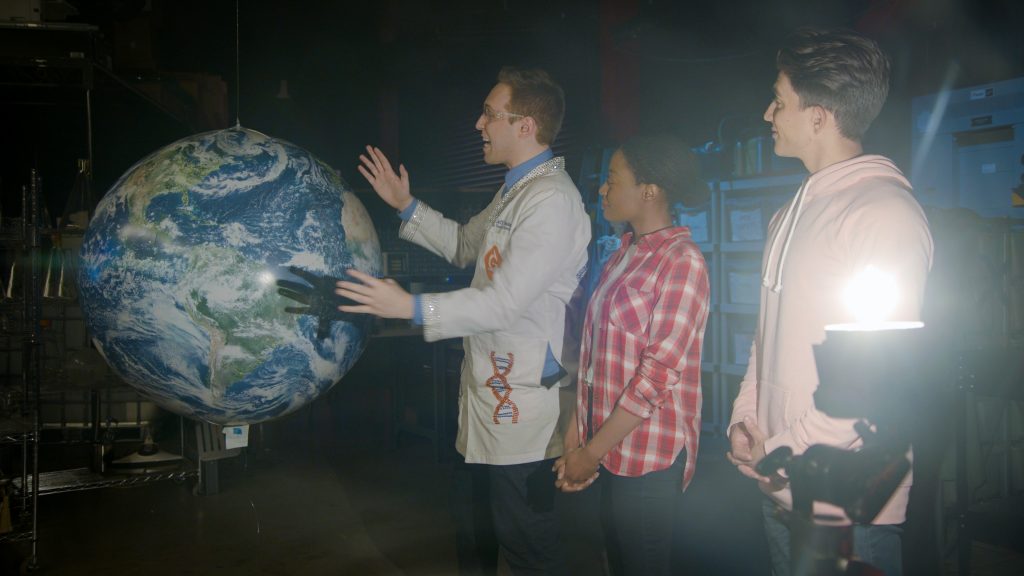
Climate is the average weather over many years. Earth’s average temperature has been increasing rapidly over the past century and a lot of evidence points to human activity as the primary cause. Moving from a dependence on fossil fuels to renewable energy resources can help decrease the amount of greenhouse gases humans put into the air, and in turn, slow down the rate at which Earth’s global temperature is increasing.
To better understand climate change…
LET’S BREAK IT DOWN!
The difference between weather and climate.
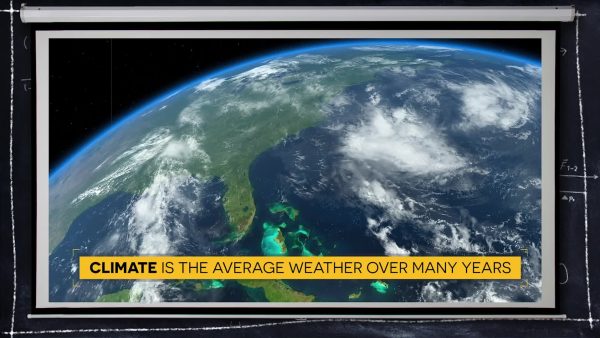
We often confuse weather and climate when we are discussing climate change. Weather is the day-to-day variations of the atmosphere’s condition locally. Which means we would describe the temperature, sky conditions (e.g., sunny, overcast), precipitation, and whether it’s windy or calm. Generally, weather can only be predicted with some degree of accuracy for seven to fourteen days.
On the other hand, climate is the long-term average weather over a large area. Different regions can have different climates. To describe the climate of a place, we might say what the temperatures are like during different seasons, how windy it usually is, or how much rain or snow typically falls. When scientists talk about climate, they're often looking at averages of precipitation, temperature, humidity, sunshine, wind, and other measures of weather that occur over a long period in a particular place. In some instances, they might look at these averages over 30 years.
You may have heard people say, “Weather tells you what to wear each day. Climate tells you what type of clothes to have in your closet.”
Climate can change over time.
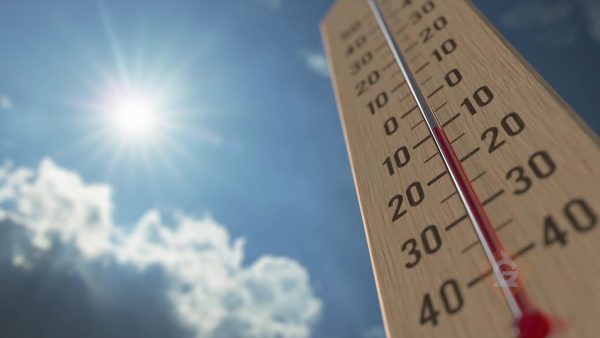
Scientists have been recording temperatures from around the world using thermometers since about 1850 and continue to do so today using sophisticated tools like satellites that measure the surface temperature all over the planet. But there are other indicators that the climate has changed over time.
Tree rings give clues about yearly weather conditions with each ring representing a year of the tree’s life. Some tree rings can be 1000 years old! Ice cores from glaciers can give us clues about the climate in the past for thousands of years. By taking data from these and other sources, scientists can reconstruct the average global temperature for thousands of years in the past. What is interesting is that the average global temperature doesn’t seem to change much from year to year – until you look at the past 100 years – which show a dramatic increase in temperature.
Exploring possible causes for the increase in global temperature.
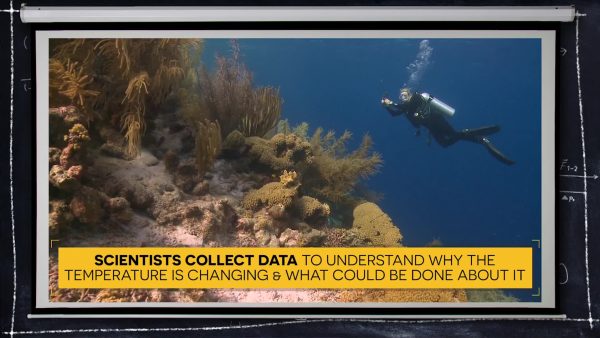
Scientists have examined many factors that might account for this increase in global temperature. Data for the amount of sunlight reaching Earth over the past 100 years shows that energy from the Sun has actually decreased in the last 50 years, while Earth’s temperature has continued to rise.
Volcanoes spew hot gases, smoke, and ash. So, maybe there has been an increase in volcanic eruptions? However, data from the past 200 years show that there has not been an increase in eruptions even though Earth’s temperature has increased.
Scientists have investigated these and many other factors that might affect climate and have found that the amount of carbon dioxide gas in the atmosphere has increased at about the same rate as global temperature increases. Just because there is a correlation (strong relationship between two measures) does not mean one causes the other. So, how might carbon dioxide cause an increase in temperature?
Greenhouse Effect
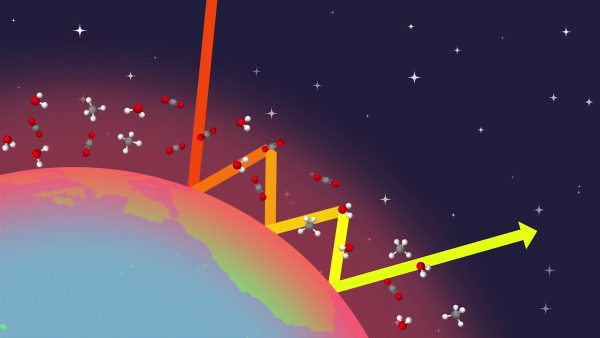
If Earth did not have an atmosphere, some of the sun’s light would hit Earth and be absorbed to become thermal energy, which would warm the ground. Some of that energy would be released back into space as infrared light. However, some gases in Earth’s atmosphere, known as greenhouse gases (carbon dioxide, methane, and water vapor), can absorb infrared light and redirect it back to Earth, which warms it even more. This effect is actually helpful. If there were no greenhouse gases at all, then the average temperature on Earth would be about –18℃!
Greenhouse gases trap thermal energy similar to how the glass in greenhouses that farmers use to grow plants trap sunlight, convert it to thermal energy, and keep it from being redirected back into the atmosphere. If you’ve ever been in a greenhouse, you know how warm they can become inside.
For millions of years the amount of carbon dioxide produced by Earth’s plants, animals, soils, and oceans was about the same as the amount absorbed, so the amount in the atmosphere stayed about the same. But a period of major industrialization and innovation took place during the late 1700s and early 1800s that became increasingly dependent on the use of fossil fuels (coal, oil, and natural gas) to power factories and transportation. Burning of fossil fuels releases carbon dioxide into the atmosphere that had been trapped as carbon buried in the ground for millennia. As the amount of carbon dioxide and other greenhouse gases increased in the atmosphere, more heat was trapped and redirected back, gradually increasing Earth’s temperature.
As we have seen, scientists have gathered and analyzed a wide range of data from hundreds to millions of years in the past. They did not form their conclusion that the increase in global temperatures is caused by human activity resulting from the burning of fossil fuels without ruling out many other possibilities. Today, 97% of climate researchers agree that the evidence supports that conclusion.
Consequences of and solutions for climate change.
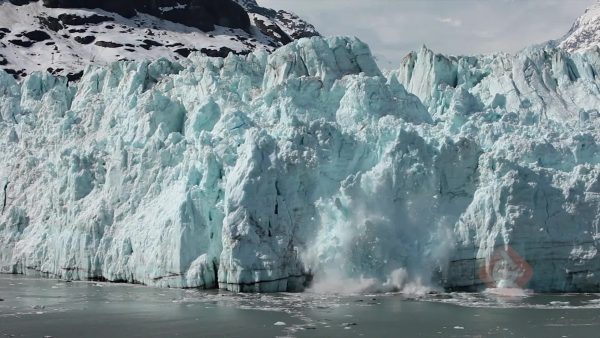
Rising temperatures impact all of Earth’s systems leading to glaciers melting, which in turn makes the sea level rise. We have seen some islands in parts of the world disappear underwater. Coastal cities like New York and Miami could be completely underwater by the year 2100. In addition, a warming global climate leads to stronger hurricanes, more severe droughts in some places, more severe flooding in others, and catastrophic wildfires.
It is not too late to fix the problem, but it will require changes in our current way of life and dependency on fossil fuels for transportation, generating electricity, heating our homes, and many other things. We need to reduce fossil fuel usage and generate energy from renewable resources like solar cells, which convert sunlight into electricity or by using biofuels, which are made from plants and algae.
We’ll need new and improved renewable energy technologies like solar cells, better batteries for electric vehicles, biofuels, nuclear power, and ways to harness energy from ocean waves, wind, and inside Earth (geothermal), which has created new career opportunities for engineers, material scientists, molecular biologists, and nuclear physicists.
INTRO TO CLIMATE CHANGE VOCABULARY
INTRO TO CLIMATE CHANGE DISCUSSION QUESTIONS
How do we know that climate has changed over time?
What are some possible reasons that might cause the climate to change?
What is the greenhouse effect?
Why is the greenhouse effect a good thing for life on Earth?
Why have greenhouse gases increased in the atmosphere over the past 100 years?
What are some consequences of a warming Earth?
Skip, I will use a 3 day free trial
Enjoy your free 30 days trial





